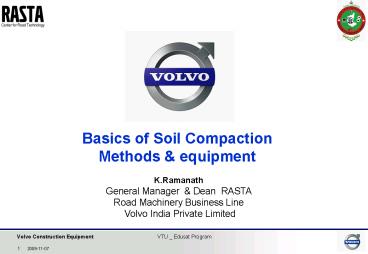Template Volvo Construction Equipment PowerPoint PPT Presentation
1 / 36
Title: Template Volvo Construction Equipment
1
Basics of Soil Compaction Methods equipment
K.Ramanath General Manager Dean RASTA Road
Machinery Business Line Volvo India Private
Limited
2
Soil Compaction
- Cost of earth work 30 Cost of road project
- Increase in heavy axle load application
- Well compacted sub-grade results in economy of
pavement thickness - Proper compaction has great economic implications
3
Road - cross section
Flexible pavement
Asphalt concrete / wearing course DBM
Aggregate 67,stone dust 24 DBM Sand 9
Bitumen 5 WMM / WBM WMM / WBM GSB GSB
Aggregate up to 80 mm Soil Soil
Muram Soil
40 mm 80 mm 80 mm 300 mm 300 mm 150 mm 150
mm 200 mm 200 mm 200 mm
10 Road thickness comprises of asphalt work -
65 of total value
4
Objectives Of Soil Compaction
- Increase in strength
- Reduction in compressibility
- Reduction in tendency for subsequent changes in
moisture content - Reduction in erodability
5
Factors Influencing Compaction
- Type of soil
- Moisture content
- Compactive effort - Energy applied per unit
weight of soil - - Weight of rammer, height of fall, number
of blows - - Weight of roller, number of passes
- Thickness of lift and type of compacting
equipment (for field compaction)
6
Moisture Content
- Water acts as a lubricant
- Too much
- takes up space
- does not allow bonding
- Too little
- same compactive effort, lower compaction
OMC - The moisture content of the soil at which
maximum density can be achieved for a given
amount of compactive effort
OMC of fine grain soils is higher than coarse
grain soils
7
Max Dry Density
Dry Density
Optimum Moisture content
Moisture content - by dry weight
8
Laboratory Compaction Tests
- Dynamic Compaction
- IS light compaction / standard proctor test
- IS heavy compaction/ modified proctor test
- Static Compaction
- Kneading Compaction
- Vibratory compaction
- usually static or dynamic compaction is
adopted
9
Comparison Of Compaction Tests
10
Moisture-density Relationship For Different
Types Of Soils
11
Field Control Of Compaction
- Measurement of dry density
- Core cutter method (IS 2720 (Part 29) - 1975)
- Sand replacement method (IS 2720 (Part 28) -
1974) - Nuclear density moisture gauge (ASTM D- 2922)
12
Sand Replacement Method
13
Nuclear Test
If calibrated
14
Field Control Of Compaction Contd
- Measurement of moisture content
- Oven Dry Method
- Sand bath drying method
- Infrared torsion balance method
- Speedy moisture meter (IS 2720 (Part 2 - 1973)
15
Rapid Moisture Meter Method
Infra Red Torsion Moisture
Balance Meter
16
Soil Compaction
- Soil Compaction is the process whereby soil
particles are constrained to pack more closely
through a reduction in air voids by mechanical
means
17
What is Compaction?
- The act of artificially densifying or increasing
the unit weight of soil by application of
external forces - Reducing the voids or pore spaces to a minimum
- Increasing the solid particle content to a
maximum.
18
Compactive Force
Water
Air
19
Details of Compactive Effort ( Compaction
methods )
Static Pressure - weight of the machine -
Mass transmitted onto the ground. Impact
- blows like that of a hammer Vibration
- energy resonates the material into a
state of equilibrium Manipulation - mends,
shears and kneads
20
(No Transcript)
21
Static Pressure
Compaction in Road Building is not just applying
pressure
22
Compactive Effort Static
Three Wheel Static Roller
Weight
23
Compaction Effect of 8 Ton Static roller
RH Rear Drum
LH Rear Drum
Static Load 2510 Kgs
Static Load 2510 Kgs
Linear applied load - 47.24
Linear applied load - 47.24
508 mm
508 mm
Front Drum
- After the first pass
- 38 Lower density on Front drum
- Higher density on Rear drum.
- Uneven mat finish.
Static Load 2980 Kgs
Linear applied load - 29.33
1016 mm
24
Tandem Roller - Compaction effect
Drum width - 1200 mm
Rear Drum
Total applied force on rear drum 4950 kgs (
Linear applied load 41.25 )
Front Drum
Total applied force on Front drum 4950 kgs (
Linear applied load 41.25 )
Equal density over full roller width. Even mat
surface after first pass
1200 mm Compacted width
25
Two Wheel Static roller
26
Compaction Effect - Impacts
- Achieve compaction -
- through a series of blows
27
Compaction Effort Vibration
More effective in overcoming internal friction
and cohesion Higher in-place density Proven
the most cost effective
28
AMPLITUDE
1.7 mm
Vertical Distance of Drum Travel
29
IMPACT SPACING
Frequency
( 1 Impact every 20 - 25 mm of travel )
LOW HIGH
ROLLER DRUM
Impact Spacing
Defined Number of complete cycles, (speed) of
the rotating device, (weight) measured in
vibrations per minute (vpm).
30
Vibrations
Compaction occurs from the bottom to the top of
the surface.
31
Compactive Effort Vibration Impact
32
Material Natural Frequency
- Soil type
- Graded sand
- Graded sand, wet
- Coastal sand, dry
- Clay
- Clay, dry, mixed w/gravel
- Sandy gravel
- Firm silt
- Loose silt
- Frequency
- 1980 VPM (33hz)
- 1440 VPM (24hz)
- 1320 VPM (22hz)
- 1200 VPM (20hz)
- 1110 VPM (18.5 hz)
- 1500-1740 VPM (25-29hz)
- 1500-1740 VPM (25-29hz)
- 1260-1980 VPM (21-33hz)
33
Compactive Effort Vibration Manipulation
34
Pad foot Soil Compactor
35
- References
- 1.IRC Special Report State of Art
- Compaction of Earthwork and
- SubgradesHRB , 1999
- 2.HMSO publication, Soil Mechanics for Road
- Engineers
- 3.Specifications for Road and Bridge Works, IV
Edition, - MoRTH, IRC Publication
36
Thank you for your attentionQuestions ? ? ?

